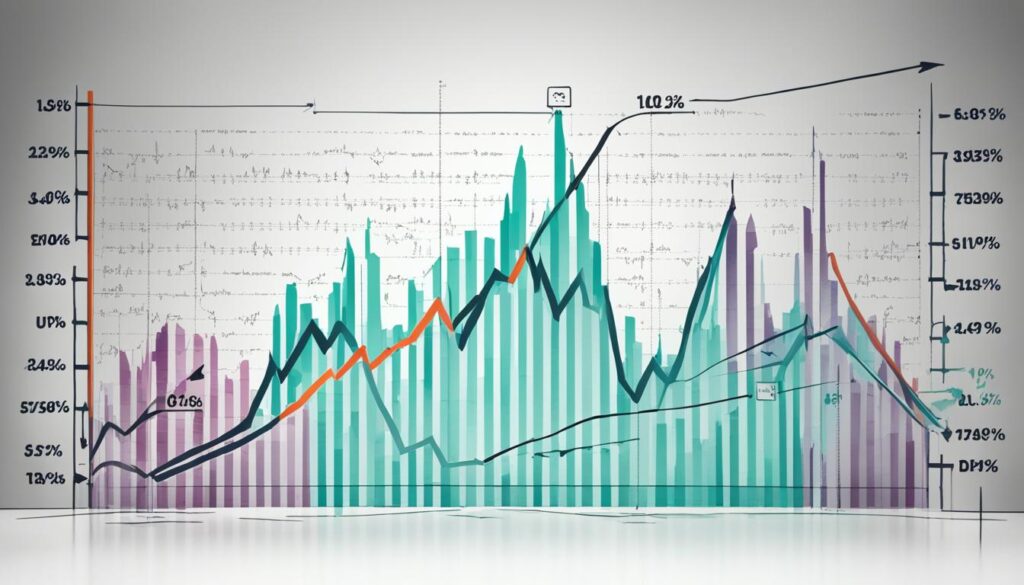Stock market volatility is how often and by how much stock prices change. The ups and downs from a stock’s average price show its volatility level. More volatility means more risk with that stock.
Many things affect this up and down movement. Economic shifts, how investors feel, world events, and even guesswork all play a part. It’s key for investors to get stock market volatility. It really matters for how well their investments do and the choices they make.
Key Takeaways:
- Stock market volatility measures the frequency and magnitude of price movements in the stock market.
- Higher volatility indicates greater risk in a security or market index.
- Volatility is influenced by economic conditions, investor sentiment, geopolitical events, and market speculation.
- Investors need to understand stock market volatility to make informed investment decisions.
- Volatility can impact portfolio performance and the overall success of investment strategies.
What Causes Stock Market Volatility?
Many things can make stock prices go up and down. These include the economy, how people feel about the market, and big news from around the world.
Economic Conditions
The economy is a big reason why the stock market can change so much. If basic things like interest rates or how much things cost go up, it can hurt businesses. This might mean less money for them and, in turn, lower stock prices. When people can’t buy as much because things are too expensive, the market can get shaky too.
Investor Sentiment and Market Speculation
How people feel and what they think can also impact the stock market. If investors believe that a company or the market is going to do well, they might buy more stock. This can shake up the prices. But if they get scared or feel negative, they might start selling, which can make prices drop fast.
Geopolitical Events
Events tied to countries’ interactions, like wars or political problems, can make the stock market less sure. These issues can hurt trade, cause risks, and change companies’ plans. When investors see these events as making things uncertain, they might change how they’re investing. This can make the market jump around a lot.
Market Shocks
There are also sudden big events that can really shake up the stock market. These might include a major company failing, a new rule hurting business, or a worldwide money problem. In these cases, people can get very worried and start selling a lot of stocks. This can make the whole market very unstable, not just one part of it.

Knowing these things can help investors be ready for the stock market’s ups and downs. Watching the economy, what people are thinking, and the world’s big news can help make smarter investing choices. This is how investors can deal with the risks of the stock market moving around so much.
Measuring Stock Market Volatility
Stock market volatility can be measured in many ways. This helps investors understand and compare how risky different stocks or markets are. By using these measures, investors can make smarter choices.
Volatility Indices
One way to gauge market volatility is with indices like the VIX. These track how volatile the market is expected to be. They give clues about what investors expect future market changes to be like.
Standard Deviation
Standard deviation is another key measure. It shows how stock or market returns vary from the average. The larger the standard deviation, the more volatile and uncertain the market is.
Beta Coefficient
Beta measures how a stock’s volatility compares to the overall market’s. A beta over 1 means the stock is usually more volatile, while under 1 means it’s less so. Investors use beta to understand the risks and potential gains of different stocks.
Implied Volatility
Implied volatility comes from options prices. It shows what the market expects future volatility to be. This is a key factor in pricing options. When implied volatility is high, so are option prices.
Investors can use these measures to understand the risk in the stock market. Knowing and watching volatility helps investors make wise investment choices and manage their investments well.

Volatility and Investment Strategies
The stock market can be both tricky and exciting. To handle its ups and downs, investing in different areas is smart. This is called diversification. It means spreading your money across various types of investments to lower the risk.
Diversification is vital to reduce the chances of losing too much in a wild market. By investing in things like tech, finance, and health, you can soften the blow of ups and downs. If one area does poorly, gains from somewhere else can help balance it out.
Looking at the big picture is also good. Long-term investors don’t worry as much when prices change daily. They focus on good quality investments that are likely to grow over time. This steady approach can pay off well.
If you think long-term, those day-to-day market changes matter less. Keeping cool and not reacting too quickly is important. Small losses now might be wins later if you stay the course. This idea needs patience and thinking ahead.
There are tools to help with market ups and downs. Setting stop-losses can protect you from big drops. Hedging, like buying options or betting against something, can also soften the impact of bad days.
But the most important thing is to stay true to your plan. Letting your feelings guide you in investing is not a good idea. It can make you do things that hurt more in the end.
By being disciplined and smart, you can do well even when times are uncertain. It’s all about sticking to a solid strategy and not letting emotions drive your choices.
Volatility and Diversification Table
| Asset Class | Yearly Return (%) | Volatility |
|---|---|---|
| Stocks | 8% | 25% |
| Bonds | 4% | 8% |
| Real Estate | 6% | 12% |
| Commodities | 2% | 20% |
This chart shows why spreading your investments is good. Stocks and commodities can jump a lot but they also offer more returns. By mixing different investments, you can lower your risks without giving up much on returns.
In the end, knowing how to manage the wild stock market is key. Using different strategies like diversifying and staying calm can make a big difference in your investments. They help lessen the shock of market changes and might help you earn more over time.

Impact of Volatility on Investment Performance
The stock market can be unpredictable, and its ups and downs greatly affect investments. Volatility means the prices of stocks or the market go up and down a lot. This can change how much money you make or lose. For anyone looking to invest smartly, knowing how this works is essential.

When markets swing a lot, it’s a chance to make more money or lose some. These changes could bring big wins or serious hits to your bet. So, it’s key for investors to think hard about how much risk they can take.
How much risk someone is willing to handle in their investments is their risk tolerance. Not everyone can stomach a bumpy market ride. If you like to play it safe, you might get pretty nervous when markets get wild. But, if you can handle more risk, you might aim for better rewards and not mind some ups and downs along the way.
Figuring out when to buy or sell because of short-term market swings is tough. This is what people mean when they talk about timing the market. It’s not something most beginners or even professionals get right all the time. A smarter move is usually to focus on your long-term plans and not get too caught up in the day-to-day market changes.
Looking at your investments’ performance, focus on the long game. Time smooths out the bumps in the market. Generally, stock markets have gone up over time, even after the really rough patches. Having a long-term approach helps dampen the hit from short-term market shake-ups.
Managing Volatility through Diversification and Risk Management
Diversifying your investments is a good way to handle market swings. By not putting all your money in one place, you’re less likely to be hurt by a single investment’s bad turn. Spread your money out to different areas to protect against big losses.
It’s also smart to use tools that protect your investments during bad market times. Setting up stop-loss orders can automatically sell off your investments before you lose too much. Plus, using certain financial tools, like options, can guard against the market going against you heavily.
Volatility and Investment Performance
| Investment Strategy | Advantages | Disadvantages |
|---|---|---|
| Diversification | Reduced exposure to individual securities or markets | Potential limited upside compared to concentrated investments |
| Long-term Investing | Focus on underlying fundamentals | Requires patience and discipline |
| Risk Management Techniques | Potential for limiting losses | Additional costs and complexities |
Tackling the effects of market ups and downs takes a mix of strategies fit for you. By picking methods that match your risk level and goals, you can deal with market changes better. Always keep learning how volatility affects your investments to make choices that move you closer to your financial aims.
Strategies for Managing Volatility
Investors can use several strategies to handle stock market ups and downs. These methods can reduce risks and improve long-term investment outcomes.
Dollar-Cost Averaging
One method is dollar-cost averaging. This means putting a set amount of money into investments regularly. Doing this over time can lower the impact of market changes. It smooths out any sudden ups and downs, which can help increase long-term gains.
Investing in Low-Volatility Stocks
Another good way is to invest in low-volatility stocks or ETFs. These are from companies with stable earnings in steady industries. Adding these to a portfolio can make it less risky. It gives investors a smoother journey.
Diversification
Spreading your money in different types of investments is key. It lessens the hit of market swings on your overall investments. This way, if one investment struggles, another might do well. Mixing stocks, bonds, and real estate can make your portfolio safer.
Staying Disciplined
It’s vital to stick to your long-term investment plans, even when the market jumps around. Avoid making snap decisions because of market fears or greed. Hang on to your goals and don’t get swayed by short-term market movements.
Handling market volatility needs smart strategies and calm decisions. Using dollar-cost averaging, picking low-volatility stocks, diversifying, and staying disciplined can boost your confidence as you invest. It helps you aim for your financial dreams even when markets are wild.
Volatility and Options Trading
Volatility is a critical part of options trading. It tells traders what the market thinks future volatility will be. When the market expects high volatility, option prices go up. This is because the chance of options making money is higher.
The Black-Scholes model is a famous way to figure out option values. It looks at different things like asset prices, time until expiration, and volatility. With these factors, traders can figure out the true value of an option.
High volatility can be good for traders. It means they could make more money if they guess price movements right. But, high volatility also means option prices increase. This can make trading more expensive and possibly lessen profits. Traders need to watch volatility closely to see its impact on their plans.
Examples of Options Pricing Models:
| Options Pricing Model | Description |
|---|---|
| Black-Scholes Model | A widely used options pricing model that considers several factors. |
| Binomial Model | It calculates option values by simulating different price paths. |
| Heston Model | This model adjusts option prices according to changing volatility. |
To do well in options trading, you must understand volatility. Traders should keep an eye on implied volatility and use pricing models. Staying informed about market conditions is also key in navigating options trading effectively.
Options trading is risky and not for everyone. It’s crucial to know the risks and get advice if needed.
Psychological Impact of Volatility
Market ups and downs really get to investors. A market drop causes fear and uncertainty. This can make people sell in a panic or make silly investment moves. But swings upwards can make people feel greedy for fast money.
When the market is wild, investors may act in biased ways. They might hate losing more than they like winning. Or they might only remember the most recent events instead of the big picture.
To handle the rollercoaster, knowing your emotions and biases is key. Instead of acting on the moment’s chaos, make choices with logic. This way, you can deal better with the stock market’s twists and turns.
Historical Examples of Stock Market Volatility
Throughout history, the stock market has had its ups and downs. Major crashes have hit investors hard and affected the global economy. Two examples include the dot-com bubble and the financial crisis of 2008.
Dot-Com Bubble
The dot-com bubble was fueled by the rapid rise of internet companies in the late 1990s. Investors piled in, hoping for big profits. However, in 2000, the bubble burst. Many tech companies failed, causing stock values to plummet and investor losses soared.
Financial Crisis of 2008
The financial crisis began with the U.S. subprime mortgage collapse. It spread worldwide, hitting the banking system hard. The outcome was a global economic downturn, affecting businesses and people everywhere.
These events highlight the risks of market ups and downs on investments. Yet, it’s important to remember the market has always bounced back, offering long-term gains to investors.
| Event | Period | Impact |
|---|---|---|
| Dot-Com Bubble | Late 1990s to early 2000s | Major market collapse, technology stocks crash |
| Financial Crisis of 2008 | 2008 | Global recession, sharp decline in stock prices |
Conclusion
Stock market ups and downs are usual in investing. They bring quick changes in prices and make the market unsure at times. But, it’s crucial for investors to keep their eyes on the future. They should stick to their investment plans.
Dealing with market swings needs a few key things: spreading out investments, managing risks, and thinking long-term. With these, you can better understand and handle market changes. This way, you are more likely to reach your financial goals.
FAQ
What is stock market volatility?
Stock market volatility shows how often and how much stock prices change. It tells us the degree to which stock prices differ from their usual average. This is for a specific security or market index.
What causes stock market volatility?
Many things can cause stock market volatility. This includes the economy’s health, how optimistic or pessimistic investors are, big global events, and guessing about the market.
How is stock market volatility measured?
Stock market volatility is measured using several methods. These include special indices, standard deviation, a stock’s beta, and implied volatility from options.
What are the strategies for managing stock market volatility?
To handle stock market ups and downs, some use diversification and invest for the long term. Others utilize risk management like stop-loss orders and hedging.
How does stock market volatility impact investment performance?
When stock prices swing a lot, both gains and losses can be big. This also affects how confident investors feel and what they decide to do with their investments.
How can investors manage stock market volatility?
Investors can deal with stock market volatility by using certain strategies. These include slowly investing money over time, choosing stocks with low volatility, and having a broad mix of investments.
How does volatility affect options trading?
Options trading is greatly impacted by volatility. It changes how much options cost and how much money traders may make or lose.
What is the psychological impact of stock market volatility?
High stock market volatility can make investors worry or be overconfident. These feelings can lead to making unwise investment choices.
Can you provide historical examples of stock market volatility?
Past episodes of significant stock market swings include the dot-com bubble and the 2008 financial crash.
What is the conclusion about stock market volatility?
Stock market volatility is a regular part of investing. By learning about it and using smart strategies, investors can do well even in volatile times.



















